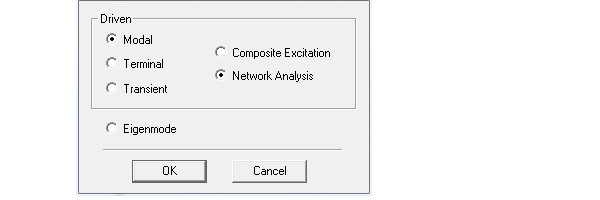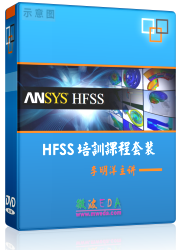Setting up an HFSS Design
Selecting the Solution Type
Before you draw the model for an HFSS project, specify the design’s solution type. As you set up your design, options available in the user interface will depend upon the selected solution type.
1. Click HFSS>Solution Type.
The Solution Type dialog box appears.

2. Select one of the following solution types:
Driven Solutions |
|
Modal |
For calculating the mode-based S-parameters of passive, high-frequency structures such as microstrips, waveguides, and transmission lines which are "driven" by a source, and for computing incident plane wave scattering. Network Analysis is the default and functions as before. Composite Excitation provides a method for solving fields in a large frequency domain problem. |
Terminal |
For calculating the terminal-based S-parameters of passive, high-frequency structures with multi-conductor transmission line ports which are "driven" by a source. This solution type results in a terminal-based description in terms of voltages and currents. Some modal data is also available. Network Analysis is the default and functions as before. Composite Excitation provides a method for solving fields in a large frequency domain problem. |
Transient |
For calculating problems in the time domain. It employs a time-domain (“transient”) solver. For Transient your choice of Composite Excitation or Network Analysis affects the options for the setup. If you select Network Analysis the setup includes an Input Signal tab for the simulation. Typical transient applications include, but are not limited to: • Simulations with pulsed excitations, such as ultra-wideband antennas, lightning strikes, electro-static discharge; • field visualization employing short-duration excitations; • time-domain reflectometry. |
Not Driven |
|
Eigenmode |
For calculating the eigenmodes, or resonances, of a structure. The Eigenmode solver finds the resonant frequencies of the structure and the fields at those resonant frequencies. Eigenmode designs cannot contain design parameters that depend on frequency, for example a frequency-dependent impedance boundary condition. |
Related Topics
Technical Notes: Solution Types
Technical Notes: Transient Solution Theory
-

国内最全面的HFSS培训课程,包含7套视频教程和2本教材,资深专家讲解,视频操作演示,结合最新工程案例,让HFSS学习不再难...【详细介绍】





